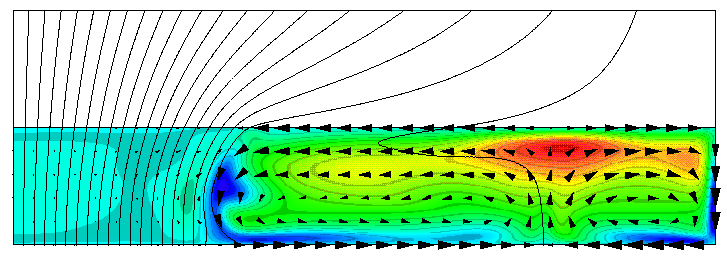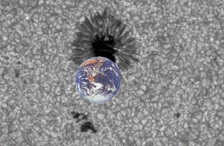|
|

|
The image on the left is by courtesy of the Stanford Solar Center and on the right was provided by Alastair Rucklidge (based on a drawing by Eugene Parker, Univ. of Chicago)
This is what a sunspot looks like close up in visible light. In fact there are two sunspots in this picture - sunspots are usually found in pairs or groups. You can also see the patterns ( granules ) of the Sun's surface ( photosphere ) all around it. It is thought that a magnetic flux tube bursts through the surface of the Sun, giving the positive and negative sunspot polarities.
|
|

|
The image on the left is by courtesy of the Stanford Solar Center and on the right was provided by Alastair Rucklidge (based on a drawing by Eugene Parker, Univ. of Chicago)
A hot object gives out more light than
a cold object. This makes sense - the hotter something is, the more energy
it has, so it gives off more energy as light. Hot objects also give out
light of a different wavelength from cold objects.
Now you might want to know: Why are sunspots cooler than the stuff all around them?
This is a really tough question and solar physicists still cannot explain it properly. One idea goes like this. All the energy of the Sun is produced in nuclear reactions at its centre. This energy seeps out through the whole Sun and eventually reaches the surface - the photosphere. This energy keeps the photosphere as hot as 6,000 degrees. But, in sunspots, the magnetic fields are very strong and they stop some of the energy getting through to the surface. Since they get less energy, sunspots are cool. Here's an illustration of a calculation. It shows the convection just below the solar surface. The dark arrows are flows. Hot gas (red) is brought up from deep layers in the Sun. The magnetic field (the dashed lines) are pushed to the edges of the convection cells. On the left hand side, where the magnetic fields are crushed up, is where the sunspots are thought to form. See how cool (blue) it is there.

Image courtesy Alastair Rucklidge, Cambridge University and Neal Hurlburt, LMSAL

Image courtesy of the Stanford Solar Center
Did you know that water had been found in sunspots? Well obviously not the liquid form that we get here on Earth, because sunspot temperatures are about 3,400 degrees, clearly well above the boiling point of water in a kettle. However, in 1995, after a careful study of the spectrum of light from sunspots, scientists found signs of water vapour in dark sunspots.
It is possible that the water in sunspots causes a sort of "solar greenhouse effect", like the one talked about in the news for the Earth, weird, or what?

|